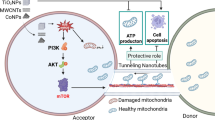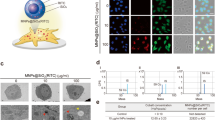Abstract
Fluorescent nanodiamonds (FNDs) as promising enzyme mimics have attracted a lot of attention in the field of biomedicine. However, the molecular mechanism of their intrinsic peroxidase-like and antioxidant activities as well as their protection of cells remain unknown. Epilepsy is a neurological disorder, manifested by repeated spontaneous seizures with complicated pathogenesis and ineffective treatments, which calls for new types of medicines. To explore the potential of using FNDs in treating epilepsy, we carried out this research and results demonstrate that FNDs have excellent optical characteristics, horseradish peroxidase, and antioxidant enzyme-like activities in mouse astrocytes. In addition, their peroxidase-like activities and optical imaging capabilities can be used to trace the localization of FNDs in cells. Moreover, the antioxidant enzyme-like activity of FNDs can reduce oxidative stress damage to astrocyte cells. More interestingly, the level of ROS, the content of MDA, the LDH leakage rate, and the expression of keap1 mRNA and protein in astrocytes from a mouse model of epilepsy seizures were decreased. On the contrary, the content of SOD, GSH, and the expression of Nrf2, HO-1 protein, and mRNA was significantly increased after incubation with FNDs. Therefore, FNDs can protect epileptic astrocytes by reducing oxidative stress through positively regulating the Nrf2/ARE pathway, inhibiting the production of free radicals and lipid peroxidation products to reduce oxidative stress. Collectively, our FNDs with minimal cytotoxicity can efficiently track their locations and protect mouse astrocytes from oxidative stress, which may provide a nano-based biomedicine platform for treating epilepsy-like neurological diseases.




Similar content being viewed by others
References
Aguiar CC, Almeida AB, Araujo PV, de Abreu RN, Chaves EM, do Vale OC, Macedo DS, Woods DJ, Fonteles MM, Vasconcelos SM (2012) Oxidative stress and epilepsy: literature review. Oxid Med Cell Longev 2012:795259. https://doi.org/10.1155/2012/795259
Antunes F, Han D, Cadenas E (2002) Relative contributions of heart mitochondria glutathione peroxidase and catalase to H(2)O(2) detoxification in in vivo conditions. Free Radic Biol Med 33(9):1260–1267. https://doi.org/10.1016/s0891-5849(02)01016-x
Augustyniak A, Michalak K, Skrzydlewska E (2005) The action of oxidative stress induced by ethanol on the central nervous system (CNS). Postepy Hig Med Dosw (online) 59:464–471
Ayala A, Muñoz MF, Argüelles S (2014) Lipid peroxidation: production, metabolism, and signaling mechanisms of malondialdehyde and 4-hydroxy-2-nonenal. Oxid Med Cell Longev 2014:360438. https://doi.org/10.1155/2014/360438
Barnett YA, King CM (1995) An investigation of antioxidant status, DNA repair capacity and mutation as a function of age in humans. Mutat Res 338(1–6):115–128. https://doi.org/10.1016/0921-8734(95)00017-z
Blanco-Suarez E, Caldwell AL, Allen NJ (2017) Role of astrocyte-synapse interactions in CNS disorders. J Physiol 595(6):1903–1916. https://doi.org/10.1113/JP270988
Celardo I, Pedersen JZ, Traversa E, Ghibelli L (2011) Pharmacological potential of cerium oxide nanoparticles. Nanoscale 3(4):1411–1420. https://doi.org/10.1039/c0nr00875c
Chen TM, Tian XM, Huang L, Xiao J, Yang GW (2017) Nanodiamonds as pH-switchable oxidation and reduction catalysts with enzyme-like activities for immunoassay and antioxidant applications. Nanoscale 9(40):15673–15684. https://doi.org/10.1039/C7NR05629J
Costello DJ, Delanty N (2004) Oxidative injury in epilepsy: potential for antioxidant therapy? Expert Rev Neurother 4(3):541–553. https://doi.org/10.1586/14737175.4.3.541
Coulter DA, Steinhauser C (2015) Role of astrocytes in epilepsy. Cold Spring Harb Perspect Med 5(3):a022434. https://doi.org/10.1101/cshperspect.a022434
Coyle JT, Puttfarcken P (1993) Oxidative stress, glutamate, and neurodegenerative disorders. Science 262(5134):689–695. https://doi.org/10.1126/science.7901908
Gao L, Zhuang J, Nie L, Zhang J, Zhang Y, Gu N, Wang T, Feng J, Yang D, Perrett S, Yan X (2007) Intrinsic peroxidase-like activity of ferromagnetic nanoparticles. Nat Nanotechnol 2(9):577–583. https://doi.org/10.1038/nnano.2007.260
Gawel S, Wardas M, Niedworok E, Wardas P (2004) Malondialdehyde (MDA) as a lipid peroxidation marker. Wiad Lek 57(9–10):453–455
Gulati K, Ray A, Pal G, Vijayan VK (2005) Possible role of free radicals in theophylline-induced seizures in mice. Pharmacol Biochem Behav 82(1):241–245. https://doi.org/10.1016/j.pbb.2005.06.019
Harvey JW (2008) Chapter 7 - The erythrocyte: physiology, metabolism, and biochemical disorders. In: Kaneko JJ, Harvey JW, Bruss ML (eds) Clinical Biochemistry of Domestic Animals (Sixth Edition). Academic Press, San Diego, pp 173–240. https://doi.org/10.1016/B978-0-12-370491-7.00007-6
Haut SR, Bigal ME, Lipton RB (2006) Chronic disorders with episodic manifestations: focus on epilepsy and migraine. Lancet Neurol 5(2):148–157. https://doi.org/10.1016/S1474-4422(06)70348-9
Hemelaar SR, Saspaanithy B, L'Hommelet SRM, Perona Martinez FP, van der Laan KJ, Schirhagl R (2018) The response of HeLa cells to fluorescent nanodiamond uptake. Sensors (Basel) 18 (2). https://doi.org/10.3390/s18020355
Huang Y-A, Kao C-W, Liu K-K, Huang H-S, Chiang M-H, Soo C-R, Chang H-C, Chiu T-W, Chao J-I, Hwang E (2014) The effect of fluorescent nanodiamonds on neuronal survival and morphogenesis. Sci Rep 4(1):6919. https://doi.org/10.1038/srep06919
Jin M, He Q, Zhang S, Cui Y, Han L, Liu K (2018) Gastrodin suppresses pentylenetetrazole-induced seizures progression by modulating oxidative stress in zebrafish. Neurochem Res 43(4):904–917. https://doi.org/10.1007/s11064-018-2496-9
Kensler TW, Wakabayashi N, Biswal S (2007) Cell survival responses to environmental stresses via the Keap1-Nrf2-ARE pathway. Annu Rev Pharmacol Toxicol 47:89–116. https://doi.org/10.1146/annurev.pharmtox.46.120604.141046
Kudin AP, Kudina TA, Seyfried J, Vielhaber S, Beck H, Elger CE, Kunz WS (2002) Seizure-dependent modulation of mitochondrial oxidative phosphorylation in rat hippocampus. Eur J Neurosci 15(7):1105–1114. https://doi.org/10.1046/j.1460-9568.2002.01947.x
Kume T (2017) Therapeutic potential of the activators of the nuclear factor erythroid 2-related factor 2–antioxidant response element pathway in brain disorders. Biol Pharm Bull 40(5):553–556. https://doi.org/10.1248/bpb.b17-00091
Kuyumcu F, Aycan A (2018) Evaluation of oxidative stress levels and antioxidant enzyme activities in burst fractures. Med Sci Monit 24:225–234. https://doi.org/10.12659/msm.908312
van der Laan KJ, Morita A, Perona-Martinez FP, Schirhagl R (2020) Evaluation of the oxidative stress response of aging yeast cells in response to internalization of fluorescent nanodiamond biosensors. Nanomaterials (Basel) 10 (2). https://doi.org/10.3390/nano10020372
Li JM, Shah AM (2004) Endothelial cell superoxide generation: regulation and relevance for cardiovascular pathophysiology. Am J Physiol Regul Integr Comp Physiol 287(5):R1014-1030. https://doi.org/10.1152/ajpregu.00124.2004
Li S, Zhou C, Zhu Y, Chao Z, Sheng Z, Zhang Y, Zhao Y (2021) Ferrostatin-1 alleviates angiotensin II (Ang II)- induced inflammation and ferroptosis in astrocytes. Int Immunopharmacol 90:107179. https://doi.org/10.1016/j.intimp.2020.107179
Liu L, Kelly MG, Yang XR, Fernandez TG, Wierzbicki EL, Skrobach A, Doré S (2020) Nrf2 deficiency exacerbates cognitive impairment and reactive microgliosis in a lipopolysaccharide-induced neuroinflammatory mouse model. Cell Mol Neurobiol 40(7):1185–1197. https://doi.org/10.1007/s10571-020-00807-4
Loboda A, Damulewicz M, Pyza E, Jozkowicz A, Dulak J (2016) Role of Nrf2/HO-1 system in development, oxidative stress response and diseases: an evolutionarily conserved mechanism. Cell Mol Life Sci 73(17):3221–3247. https://doi.org/10.1007/s00018-016-2223-0
Mohan N, Chen CS, Hsieh HH, Wu YC, Chang HC (2010) In vivo imaging and toxicity assessments of fluorescent nanodiamonds in Caenorhabditis elegans. Nano Lett 10(9):3692–3699. https://doi.org/10.1021/nl1021909
Moore L, Yang J, Lan TT, Osawa E, Lee DK, Johnson WD, Xi J, Chow EK, Ho D (2016) Biocompatibility assessment of detonation nanodiamond in non-human primates and rats using histological, hematologic, and urine analysis. ACS Nano 10(8):7385–7400. https://doi.org/10.1021/acsnano.6b00839
Nair DR (2016) Management of drug-resistant epilepsy. Continuum (Minneap Minn) 22 (1 Epilepsy):157–172. https://doi.org/10.1212/CON.0000000000000297
Niki E (2016) Oxidative stress and antioxidants: distress or eustress? Arch Biochem Biophys 595:19–24. https://doi.org/10.1016/j.abb.2015.11.017
Patel M (2004) Mitochondrial dysfunction and oxidative stress: cause and consequence of epileptic seizures. Free Radical Biol Med 37(12):1951–1962. https://doi.org/10.1016/j.freeradbiomed.2004.08.021
Patel DC, Tewari BP, Chaunsali L, Sontheimer H (2019) Neuron-glia interactions in the pathophysiology of epilepsy. Nat Rev Neurosci 20(5):282–297. https://doi.org/10.1038/s41583-019-0126-4
Perucca E, French J, Bialer M (2007) Development of new antiepileptic drugs: challenges, incentives, and recent advances. Lancet Neurol 6(9):793–804. https://doi.org/10.1016/S1474-4422(07)70215-6
Rzigalinski BA, Meehan K, Davis RM, Xu Y, Miles WC, Cohen CA (2006) Radical nanomedicine. Nanomedicine (lond) 1(4):399–412. https://doi.org/10.2217/17435889.1.4.399
Sargis RM, Subbaiah PV (2006) Protection of membrane cholesterol by sphingomyelin against free radical-mediated oxidation. Free Radical Biol Med 40(12):2092–2102. https://doi.org/10.1016/j.freeradbiomed.2006.02.005
Schrand AM, Huang H, Carlson C, Schlager JJ, Omacr Sawa E, Hussain SM, Dai L (2007) Are diamond nanoparticles cytotoxic? J Phys Chem B 111(1):2–7. https://doi.org/10.1021/jp066387v
Seifried HE, Anderson DE, Fisher EI, Milner JA (2007) A review of the interaction among dietary antioxidants and reactive oxygen species. J Nutr Biochem 18(9):567–579. https://doi.org/10.1016/j.jnutbio.2006.10.007
Shenderova OA, Shames AI, Nunn NA, Torelli MD, Vlasov I, Zaitsev A (2019) Review Article: Synthesis, properties, and applications of fluorescent diamond particles. J Vac Sci Technol B Nanotechnol Microelectron 37(3):030802. https://doi.org/10.1116/1.5089898
Shi W, Wang Q, Long Y, Cheng Z, Chen S, Zheng H, Huang Y (2011) Carbon nanodots as peroxidase mimetics and their applications to glucose detection. Chem Commun 47(23):6695–6697. https://doi.org/10.1039/C1CC11943E
Singh A, Trevick S (2016) The epidemiology of global epilepsy. Neurol Clin 34(4):837–847. https://doi.org/10.1016/j.ncl.2016.06.015
Song Y, Qu K, Zhao C, Ren J, Qu X (2010) Graphene oxide: intrinsic peroxidase catalytic activity and its application to glucose detection. Adv Mater 22(19):2206–2210. https://doi.org/10.1002/adma.200903783
Turski WA, Cavalheiro EA, Schwarz M, Czuczwar SJ, Kleinrok Z, Turski L (1983) Limbic seizures produced by pilocarpine in rats: behavioural, electroencephalographic and neuropathological study. Behav Brain Res 9(3):315–335. https://doi.org/10.1016/0166-4328(83)90136-5
Ursini F, Maiorino M (2013) Glutathione peroxidases. In: Lennarz WJ, Lane MD (eds) Encyclopedia of biological chemistry (Second Edition). Academic Press, Waltham, pp 399–404. https://doi.org/10.1016/B978-0-12-378630-2.00383-2
Valiev R (2002) Materials science: nanomaterial advantage. Nature 419(6910):887–889. https://doi.org/10.1038/419887a
Valko M, Rhodes CJ, Moncol J, Izakovic M, Mazur M (2006) Free radicals, metals and antioxidants in oxidative stress-induced cancer. Chem Biol Interact 160(1):1–40. https://doi.org/10.1016/j.cbi.2005.12.009
Vasconcelos AR, Dos Santos NB, Scavone C, Munhoz CD (2019) Nrf2/ARE Pathway modulation by dietary energy regulation in neurological disorders. Front Pharmacol 10:33. https://doi.org/10.3389/fphar.2019.00033
Wei H, Wang E (2013) Nanomaterials with enzyme-like characteristics (nanozymes): next-generation artificial enzymes. Chem Soc Rev 42(14):6060–6093. https://doi.org/10.1039/C3CS35486E
Wu H, Wang Y, Ying M, Jin C, Li J, Hu X (2021) Lactate dehydrogenases amplify reactive oxygen species in cancer cells in response to oxidative stimuli. Signal Transduct Target Ther 6(1):242. https://doi.org/10.1038/s41392-021-00595-3
Zhu X, He Y, Liu Z, Zhu Z, He Y, Qiu J, Liu D, Mo M, Wang P, Tian X, Xu P (2020) A novel carbazole-based hydrogen-sulfide donor suppresses seizures and upregulates ATP-sensitive potassium channels. Appl Mater Today 19:100559. https://doi.org/10.1016/j.apmt.2020.100559
Zhuang J, Fan K, Gao L, Lu D, Feng J, Yang D, Gu N, Zhang Y, Liang M, Yan X (2012) Ex vivo detection of iron oxide magnetic nanoparticles in mice using their intrinsic peroxidase-mimicking activity. Mol Pharm 9(7):1983–1989. https://doi.org/10.1021/mp300033a
Acknowledgements
We are grateful to Prof. Guowei Yang and Dr. Tongming Chen for providing the FNDs.
Funding
This work was funded by the National Nature Science Foundation of China (81771891), the Natural Science Foundation of Guangdong Province (Q195026028), Health Commission of Zhejiang Province (2020KY632), Wenzhou Municipal Science and Technology Bureau (Y20190058, Y2020223).
Author information
Authors and Affiliations
Corresponding authors
Ethics declarations
Conflict of interest
The authors declare that they no conflict of interest.
Additional information
Publisher's note
Springer Nature remains neutral with regard to jurisdictional claims in published maps and institutional affiliations.
Rights and permissions
About this article
Cite this article
Wang, N., Zhang, M., Ma, Y. et al. Fluorescent nanodiamonds as enzyme mimics for protecting astrocytes from oxidative stress in a mouse model of epilepsy. J Nanopart Res 23, 266 (2021). https://doi.org/10.1007/s11051-021-05381-4
Received:
Accepted:
Published:
DOI: https://doi.org/10.1007/s11051-021-05381-4




